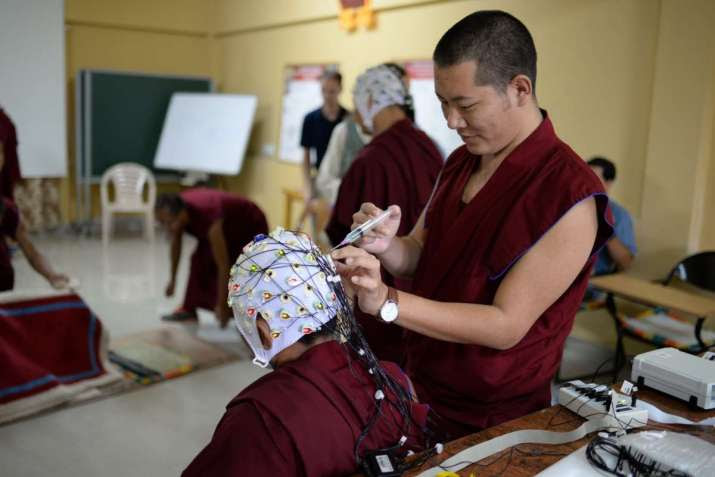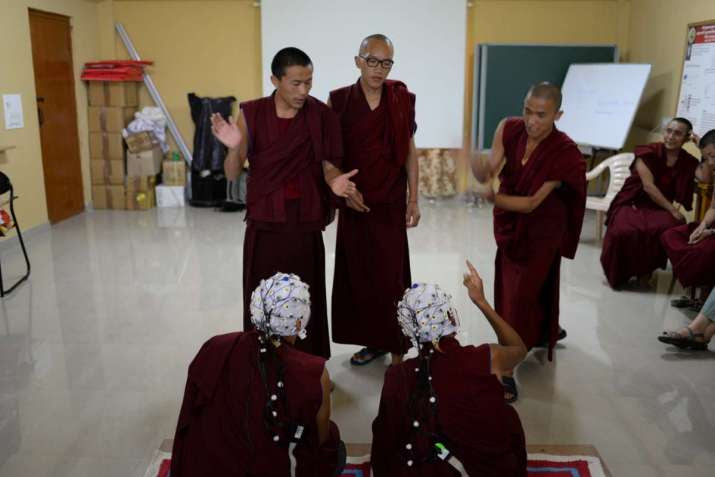
Sera Mey Monastic University is one of the biggest monastic seats of learning whose history can be traced back to hundreds of years since the time of Tsongkhapa disciple Kunkhyen Jangchup Bhumpa. Since the influx of Tibetans into exile as refugees, the world has seen a new face of Buddhism, and the sophistication of its vast philosophy and the practicality of its mind training instructions have impressed and lured many intellectuals as well as scientists into it from all around the world.
A group of researchers from the Science for Monks project and Kent State University have been measuring the brain activity of Buddhist monks engaged in monastic debates. The research, which took place from 29 July–12 August at Sera Jey Monastic University in Bylakuppe, India, used electroencephalograph (EEG) technology to measure neural oscillation in the brain as the monks engaged in serious debates on topics ranging from emptiness to cosmology.
“We are here to map the brain activity of the Buddhist monks when they debate,” said Bryce Johnson, president and CEO of Science for Monks. “We want to understand what goes on in their brain and when the neurons synchronize.” (The Times of India)
Debating is a common activity for the monks—not merely an academic exercise, but a way to analyze the nature of reality. Ngawang Norbu, a member of the Sera Jay Science Centre, explained: “An important objective is to apply the knowledge to practical situations. His Holiness the Dalai Lama often emphasizes that mere learning is not as useful as practical applications of knowledge.” (The Times of India)

Debating is a highly structured and stylized activity in Tibetan Buddhism, based on two roles or positions that the monks can take: there is a challenger, usually a more senior monk, who stands and asks questions, and a defender, usually a junior monk, who sits on the floor and tries to answer the questions posed to him by the challenger. The debates begin in a very civilized manner, but as they progress the challenger starts to use physical expressions of doubt: when he has caught an error of reasoning by the defender or wants to challenge an answer, he will stomp his left foot and clap his hands, signifying the meeting of compassion (right hand) and wisdom (left hand).
During the research, the monks were debating Buddhist theses as they normally would at the university, but with one difference; their usually clean-shaven heads were now covered with white electrode caps, which are part of the EEG equipment used to monitor their brain activity. EEG technology documents the repetitive activity of neurons, also known as neural oscillation, which is a “fundamental mechanism that enables the synchronization of neural activity within and across brain regions and promotes the precise coordination of neural processes underlying cognition, memory, perception, and behavior.” The neural oscillation is influenced by task constraints, such as attention. (ScienceDirect)

As David M. Fresco, professor of psychological sciences at Kent State University, observed, “The EEG captures the moments in the monks’ brains when they are engaged in debate. When do the neurons synchronize? What is the quality of attention during the course of the debate? If there is [neural] synchronization between the two monks, when does it occur? This is what we are finding out.” In addition, the research also examines the differences in the brain activity of junior and senior monks. (The Times of India)
The data gathered during the research has yet to be analyzed, but Johnson noted that the monks were very interested in participating in the research: “The monks see this as strengthening Buddhism. This is all part of the ancient Nalanda tradition,” he said. (The Times of India)
The project at Sera Jey Monastic University is an example of the research conducted by Science for Monks, an organization created in 2001 based on the Dalai Lama’s personal interest in science. Science for Monks seeks to introduce Western science and scientific education and dialogue to monastic education.
The sophistication of its vast philosophy and the practicality of its mind training instructions have impressed and lured many intellectuals as well as scientists into it from all around the world. This rich and profound philosophy of Buddhism has been kept intact through the practice of study, contemplation and meditation for many centuries in Tibet. As the world outside is now showing a keen interest in our culture, a need for a source of information on our monastic life of study, contemplation and meditation is needed.











